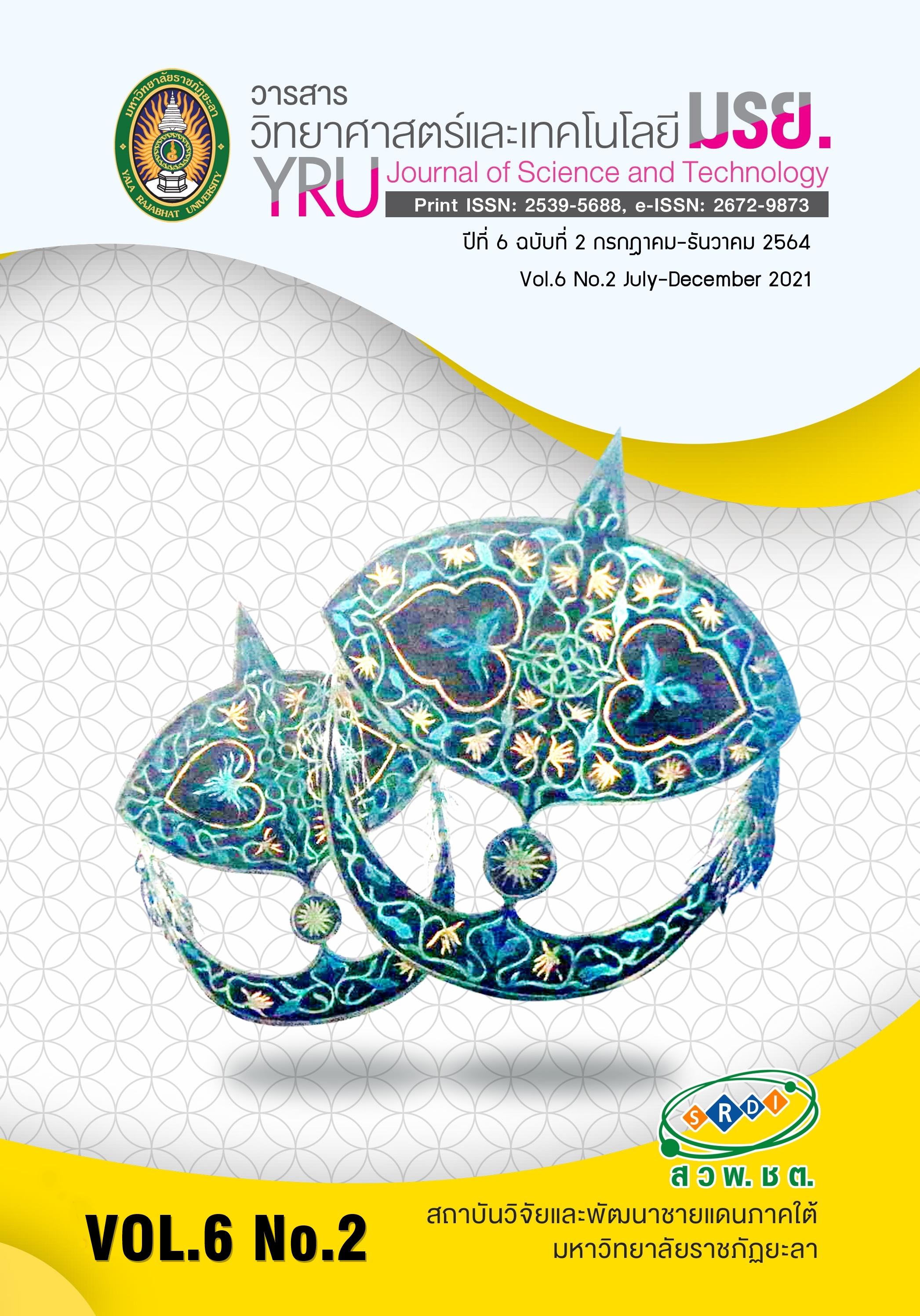องค์ประกอบทางเคมี และฤทธิ์ต้านเชื้อแบคทีเรียของสารสกัดเหง้าว่านนางคำ
Main Article Content
บทคัดย่อ
งานวิจัยนี้ได้ทำการสกัดแยกสารออกฤทธิ์ทางชีวภาพจากเหง้าว่านนางคำ และวิเคราะห์องค์ประกอบทางเคมีของตัวอย่างสารสกัดหยาบโดยเทคนิคลิควิดโครมาโทกราฟี-แมสส์สเปกโทรเมตรี จากผลการวิเคราะห์พบองค์ประกอบทางเคมีจำนวน 5 ชนิด แบ่งได้เป็น 2 กลุ่ม คือ (1) กลุ่มเคอร์คิวมินอยด์: Bisdemethoxycurcumin Demethoxycurcumin Curcumin และ (2) กลุ่มองค์ประกอบระเหยได้: Furanodienone และ Turmerone จากนั้นได้ทดสอบฤทธิ์ของสารสกัดหยาบที่ได้ในการต้านเชื้อแบคทีเรียก่อโรคผิวหนังในมนุษย์ จำนวน 3 สายพันธุ์ คือ Staphylococcus aureus DMST 8840 Staphylococcus epidermidis DMST 15505 และ Methicillin-resistant Staphylococcus aureus (MRSA) DMST 20651 ผลการทดสอบพบว่าตัวอย่างสารสกัดมีประสิทธิภาพในการยับยั้งการเจริญของเชื้อแบคทีเรียได้ทั้ง 3 สายพันธุ์ โดยมีค่า minimal inhibitory concentration (MIC) เท่ากับ 25.60 มิลลิกรัม/มิลลิลิตร และมีประสิทธิภาพในการทำลายเชื้อแบคทีเรียทดสอบโดยมีค่า minimal bactericidal concentration (MBC) อยู่ในช่วง 25.60-51.20 มิลลิกรัม/มิลลิลิตร
Article Details
บทความ ข้อมูล เนื้อหา รูปภาพ ฯลฯ ที่ได้รับการเผยแพร่ในวารสารวิทยาศาสตร์และเทคโนโลยี มรย. นี้ ถือเป็นลิขสิทธิ์ของวารสารวิทยาศาสตร์และเทคโนโลยี มรย. หากบุคคลหรือหน่วยงานใดต้องการนำทั้งหมดหรือส่วนหนึ่งส่วนใดไปเผยแพร่ต่อหรือกระทำการใดๆ จะต้องได้รับอนุญาตเป็นลายลักษณ์อักษรจากวารสารวิทยาศาสตร์และเทคโนโลยี มรย. ก่อนเท่านั้น
เอกสารอ้างอิง
Ashraf, K., Mujeeb, M., Ahmad, A., Ahmad, N. & Amir, M. (2015). Determination of curcuminoids in Curcuma longa Linn. by UPLC/Q-TOF–MS: an application in turmeric cultivation. Journal of Chromatographic Science, 53(8), 1346-1352.
Basri, D.F. & Fan, S.H. (2005). The potential of aqueous and acetone extracts of galls of Quercus infectoria as antibacterial agents. Indian Journal of Pharmacology, 37(1), 26-29.
Chao, I.C., Wang, C.M., Li, S.P., Lin, L.G., Ye, W.C. & Zhang, Q.W. (2018). Simultaneous quantification of three curcuminoids and three volatile components of Curcuma longa using pressurized liquid extraction and high-performance liquid chromatography. Molecules, 23(7), 1-9.
Deng, Z., Liu, Q., Wu, W. & Wang, H. (2020). Validation and application of a novel UHPLC–MS/MS method for the measurement of furanodienone in rat plasma. Biomedical Chromatography, 34(1), 1-8.
Enright, M.C., Robinson, D.A., Randle, G., Feil, E.J., Grundmann, H., & Spratt, B.G. (2002). The evolutionary history of methicillin-resistant Staphylococcus aureus (MRSA). Proceedings of the National Academy of Sciences of the United States of America, May 28, 2002. 99(11), 7687-7692.
Essien, E.E., Newby, J.S., Walker, T.M., Setzer, W.N., & Ekundayo, O. (2015). Chemotaxonomic characterization and in-vitro antimicrobial and cytotoxic activities of the leaf essential oil of Curcuma longa grown in southern Nigeria. Medicines, 2(4), 340-349.
Kumar, A., Chomwal, R., Kumar, P. & Renu, S. (2009). Anti-inflammatory and wound healing activity of Curcuma aromatica Salisb extract and its formulation. Journal of Chemical and Pharmaceutical Research, 1(1), 304-310.
Kumar, S., Narain, U., Tripathi, S. & Misra, K. (2001). Syntheses of curcumin bioconjugates and study of their antibacterial activities against β-lactamase-producing microorganisms. Bioconjugate Chemistry, 12(4), 464-469.
Lee, J., Jung, Y., Shin, J.H., Kim, H., Moon, B., Ryu, D., et al. (2014). Secondary metabolite profiling of Curcuma species grown at different locations using GC/TOF and UPLC/Q-TOF MS. Molecules, 19(7), 9535-9551.
Li, Y., Wo, J.M., Liu, Q., Li, X. & Martin, R.C.G. (2009). Chemoprotective effects of Curcuma aromatica on esophageal carcinogenesis. Annals of Surgical Oncology, 16, 515-523.
Liu, B., Gao, Y.Q., Wang, X.M., Wang, Y.C. & Fu, L.Q. (2014). Germacrone inhibits the proliferation of glioma cells by promoting apoptosis and inducing cell cycle arrest. Molecular Medicine Reports, 10(2), 1046-1450.
Panich, U., Kongtaphan, K., Onkoksoong, T., Jaemsak, K, Phadungrakwittaya, R., Thaworn, A., et al. (2010). Modulation of antioxidant defense by Alpinia galanga and Curcuma aromatica extracts correlates with their inhibition of UVA-induced melanogenesis. Cell Biology and Toxicology, 26(2), 103-116.
Pant, N., Misra, H. & Jain, D.C. (2010). Phytochemical investigation of ethyl acetate extract from Curcuma aromatica Salisb. rhizomes. Arabian Journal of Chemistry, 6, 279-283.
Rahman, A.F.M.M., Angawi, R.F. & Kadi, A.A. (2015). Spatial localisation of curcumin and rapid screening of the chemical compositions of turmeric rhizomes (Curcuma longa Linn.) using Direct Analysis in Real Time-Mass Spectrometry (DART-MS). Food Chemistry, 173, 489-494.
Rahman, M., Kuhn, I., Rahman, M., Olsson-Liljequist, B. & Mollby, R. (2004). Evaluation of a scanner-assisted colorimetric MIC method for susceptibility testing of gram-negative fermentative bacteria. Applied and Environmental Microbiology, 70(4), 2398–2403.
Sikha, A., Harini, A. & Hegde, P.L. (2015). Pharmacological activities of wild turmeric (Curcuma aromatica Salisb): a review. Journal of Pharmacognosy and Phytochemistry, 3(5), 1-4.
Siramon, P & Weanukul, R. (2020). Using ultrasound-assisted solvent extraction of phenolic compounds from Curcuma aromatica Salisb. rhizomes. Journal of Science & Technology, Ubon Ratchathani University, 22(1), 40-44. (in Thai)
Xiang, H., Zhang, L., Yang, Z., Chen, F., Zheng, X. & Liu, X. (2017). Chemical compositions, antioxidative,
antimicrobial, anti-inflammatory and antitumor activities of Curcuma aromatica Salisb. essential oils. Industrial Crops and Products, 108, 6-16.
Yin, G., Cheng, X., Tao, W., Dong, Y., Bian, Y., Zang, W., et al. (2018). Comparative analysis of multiple representative components in the herb pair Astragali Radix-Curcumae Rhizoma and its single herbs by UPLC-QQQ-MS. Journal of Pharmaceutical and Biomedical Analysis, 148, 224-229.


